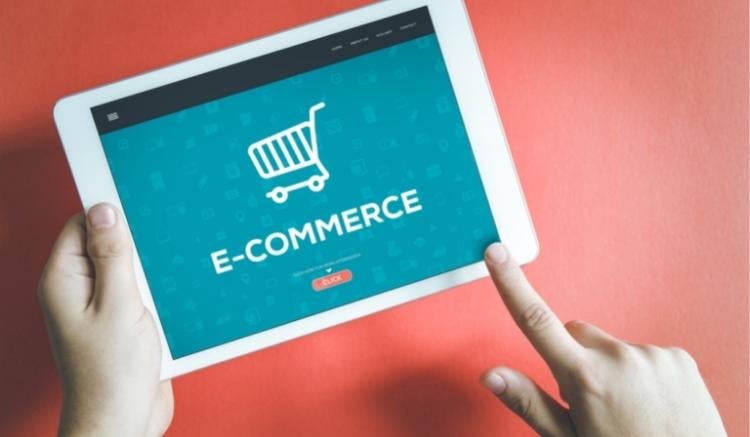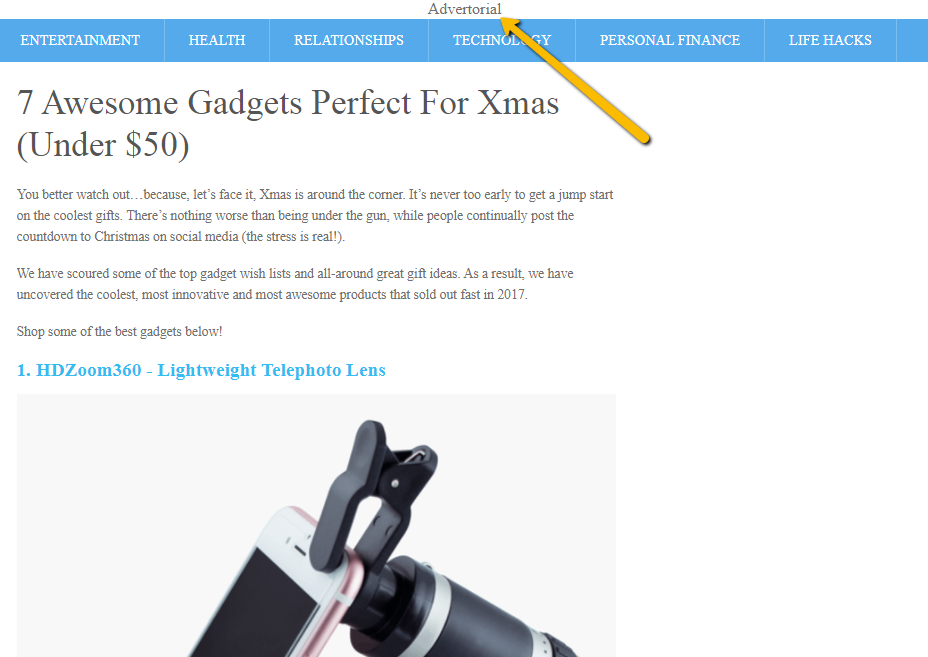As e-commerce becomes an increasingly popular way to shop, businesses are looking for new and innovative ways to reach consumers. One of the most effective ways to do this is through native advertising.

Native advertising is a form of advertising that blends in with the user experience of the platform it’s on. This can be done in a number of ways, such as through sponsored content, promoted tweets, promoted pins, or content recommendations.
It is specifically designed to match the form and function of the platform on which it appears, which means that it looks like an organic part of the user experience rather than an advertisement.
Because native advertising looks like regular content, it is more likely to be clicked on and shared than traditional advertisements. In fact, a study by Sharethrough found that native ads are clicked on twice as often as traditional banner or display ads.
Also, based on a consumer study by the UN, a bulk of our population has switched to online purchasing for almost everything they need. And since they have seen the convenience of buying online, even when industries are opening once again and are going back to normal, people will continue to make more and more online purchases.
This is good news for eCommerce companies. And you can help people filter out the ad noise by turning to native ad campaigns.
Why Use Native Advertising for eCommerce?
If you're looking to increase traffic and conversions for your eCommerce site, native advertising may be the answer. There are a number of benefits to using native advertising for eCommerce, primarily:
1. It helps to build trust between the business and the customer.
Ads are everywhere, and customers are getting tired of them. They're also becoming savvier about telling the difference between an ad and regular content.
Customers are already wary of ads, and they're getting better at telling the difference between an ad and regular content. If you want them to trust you enough to buy your product, you need to find a way to get your message across without looking like an ad.
Native ads look like regular content, so customers are more likely to trust them. This is especially important for eCommerce businesses, as customers need to trust that you are selling legitimate products. As a result, businesses can reach more people with their message and generate more sales and subscribers.
2. Native advertising can be more effective than the traditional display of advertising.
You've seen the stats—banner blindness is real, and it costs businesses billions of dollars in lost revenue.
It's no secret that display ads are becoming less and less effective. People are tuning out ads, and companies are losing money as a result.
Native advertising can be more effective than traditional display ads because it looks like regular content on the page. This means people are more likely to click on it and read what you have to say.
Studies have shown that native ads are more likely to be clicked on and that they generate higher conversion rates for landing pages than other forms of advertising.
3. Native advertising is a great way to get traffic towards your eCommerce site.
By placing targeted ads in the right places, you can direct traffic to your site or landing pages.
With native advertising, you can place ads on high-quality websites that are relevant to your target audience. These ads look like regular articles or blog posts, so people are more likely to click on them. And since they're coming from trusted sources, customers are more likely to trust your brand and buy from you.

4. Native advertising can increase brand awareness.
As we've discussed in our article on brand awareness strategy, a strong brand can equal strong sales.
It can be tough to break through the noise and get your message in front of the right people, but native advertising is a great way to do just that.
By placing your ad content and eCommerce brands in a place where they will be seen by people who are already interested in what you have to offer, you can dramatically increase your chances of getting remembered.
When customers see your ad multiple times, they are more likely to remember your brand and what you offer. As a result, they may be more likely to visit your site in the future.
5. The trust audiences have on the premium publishers' websites will be shared with the advertiser's page.
As audiences become more aware of the advertising around them, they are also growing more skeptical of the motives behind these advertisements.
This is why advertisers are constantly looking for new and innovative ways to capture the attention of their target audiences, but this is becoming increasingly difficult as audiences grow more suspicious.
However, native advertising offers a way for advertisers to share the trust that audiences have in the publishing site with their own page. By creating content that is seamlessly integrated into the surrounding editorial content, native advertisements avoid coming across as intrusive or deceptive. This makes it more likely that audiences will pay attention to and even interact with these ads.
Tips to Using Native Advertising for eCommerce
There are a number of ways that you can use native advertising for your eCommerce business. The most effective way to do this will depend on your business and your target audience.
However, some general tips for using native advertising for eCommerce include:
1. Choose the right platform.
Not all platforms are created equal when it comes to native advertising.
When it comes to choosing a native ad network, it's important to do your research and find the one that is best suited for your business. Different networks offer different features and services, so it's crucial to find one that has everything you need.
Some things to consider when choosing a network include:
- The type of ads the network offers;
- The size and reach of the network;
- The quality of the publishers on the network;
- The type of audience the network targets;
- The rates that the network charges and the minimum deposit or daily budget to run a native ad campaign (this is especially important for small businesses as you would want to manage your budget properly);
- The features the network offers such as targeted demographics, retargeting, and reporting tools.
There are almost 40 native ad networks available, and you can find them in our ultimate list of native ad providers.
2. Create catchy headlines and use eye-catching images.
Since native ads are more likely to be clicked on than display ads, it’s important to make sure your headline and image are enticing enough to get people to click through.
Don't write your headline as if you are creating a banner ad; neither should you create a clickbaity headline—people are already distrustful of such styles. Read through our guide to creating the perfect native ad headline to give you an idea.
If it is your first time using native ads for your business, then you should use a spy tool. Spy tools are services that allow you to see how your competition is using native advertising so that you can adapt and improve your own campaigns.
Read our guide on how to spy on your competitor's native advertising campaign.
3. Target your audiences properly.
Native ads allow advertisers to target their audience in a much more specific manner than other forms of advertising. This means that the right people will see them, and they can convert into paying customers if you target your audience properly through interest filters, website choices, and whatever demographic options are available in your chosen ad network.
You need to make sure that your native ad has the right targeting in place, though, because if not, then it won’t be effective at all. It needs to reach the right people who are interested in what your company has to offer, or else it just won’t work out well for anyone involved.
4. Write RELEVANT content.
One of the most important things to remember when creating native ads is to write RELEVANT content on your landing pages. Don’t just copy and paste your ad into the platform—take the time to write something that will engage your audience.
Also, make sure that your content is tailored to the platform on which it will appear. For example, if you’re using sponsored content, make sure the tone and style of the article match that of the site it’s being published on.
Write interesting and informative articles for your eCommerce brands. As with any other type of advertising, the most effective way to use native ads is by providing valuable and interesting content.
When you create quality content that is relevant to your target audience, they are more likely to read it, share it, and even buy from you. This is because people are more likely to trust information that comes from a reputable source.
By publishing interesting and informative articles that are related to your products or services, you can increase traffic to your site and encourage customers to buy from you.

5. Create a landing page suitable for your ad.
Don't just direct your customers to the product page. Instead, create a landing page that suits your native ad copy. This means creating a unique pre-lander to warm your customers up.
You can also use advertorials as landing pages, which are like mini-articles that introduce your product and help persuade customers to buy from you. You can find more information about creating advertorials in our guide.
We have analyzed a lot of native ads landing pages, including those falling under eCommerce. Check out the top eCommerce landing pages that we've analyzed to see how successful businesses did it.
6. See how your competitors are using native ads.
If you are really finding it hard to create native ads all by your lonesome, you can always spy on your competitors' ads. See how they are targeting their audiences, what kind of content they are writing, and how well it is performing. You can spy on the actual ad title, ad description, ad image, landing page, keywords, targets, geolocations, and more.
Once you have an idea of what's working for them, you can adapt and improve upon their methods to create ads that work even better for your own business.
Use a native ad spy tool like Anstrex or AdPlexity to get all the information you need about your competitor's native ads campaigns. Learn about spying on your competitors here.
7. Measure and analyze your results.
Once you have launched your native ad campaign, it’s important to track the results and see how well it is performing. Use analytics tools to measure things like click-through rates, conversion rates, and audience engagement.
Not all native ad networks have the exhaustive reporting dashboard that advertisers are looking for, though, so it would be best to utilize a third-party ad tracking and management tool like Brax.
Brax provides in-depth insights into all your native and programmatic ad spending. It can be integrated into the top native ad networks, including Yahoo Gemini, Taboola, and Outbrain, to name a few. Book a demo to see how our platform can make your advertising life so much easier.

8. Use retargeting for even better results.
Retargeting allows you to target people who have already visited your site, and as we all know, it’s cheaper and more effective to market to people who are already interested in what you have to offer.
Also known as Remarketing, this is an effective marketing technique that is proven to deliver better ROI on ad spend than any other marketing strategy available today. Furthermore, the quality of audiences you get using native ads remarketing is of high quality because these are the ones that have seen you before and have already evaluated or shown interest in your business or product.
9. Use social media to amplify your campaign.
Make sure to use social media to amplify your native ad campaign. This means sharing your ads on Twitter, Facebook, and any other social media platforms that you use.
You can also use social media to further engage with your audience and encourage them to buy from you through ads. Social Media Marketing is a whole different beast, but it works side by side with native ads as social media ads are, by definition, also native ads.
You can use Facebook Ads (now called Meta), Instagram Ads, Twitter Ads, Pinterest Ads, Tiktok Ads, and more.
10. Rinse and Repeat.
Native advertising is a continuous process, so make sure to keep track of what's working and what isn't so you can continue improving your campaigns.
Remember to always test and measure your results so you can fine-tune your strategy until you achieve the desired results.
And most importantly, have fun with it! Native advertising can be a lot of fun when you get creative with your ideas.
5 Best eCommerce Native Ad Techniques
Now that you know how beneficial native advertising actually is for eCommerce and you've learned some tricks on getting started, let's dive into a more advanced topic: actual marketing techniques.
In this section, we'll discuss some of the most effective ways to market your products based on our personal experience and based on the results of our ad intelligence research.
1. Listicle Article
Listicle article ads are a great way to introduce your product to a new audience. These are articles that feature a list of items, and they are usually formatted in an attention-grabbing way.

Since listicles are so popular on the internet, using them as the basis for your ad campaign can be very effective. You can create a list of reasons why someone should buy your product, or you can list the features and benefits of using your product.
You can even create a listicle that lists down your product as one of the choices. The important thing to do here is to make sure there is only one way out of the article, and that is by clicking a link to your own offer.
This type of ad is very versatile and can be used for products in a wide range of industries.
2. Problem Solving Advertorial
The problem-solving ad technique is a great way to show how your product can help solve the problems of your target audience. This type of native advertising usually starts with a story or situation that is common among your target market.
Then, it shows how your product can help to solve the problem. It ends with a strong call to action that encourages the reader to buy your product.
Since this type of ad is very persuasive, it is perfect for products that are aimed at solving a problem. It can be used for products in any industry, but it is most effective for products that are seen as a solution to a common problem, such as household items.
For this technique to achieve the maximum impact, you should understand your audience's pain points. What are the problems that they are struggling with? What are their biggest concerns? Once you know that, you can create an ad campaign that is specifically tailored to address those issues.
3. Social Proof Ad
Social proof is a powerful psychological principle that states that people are more likely to do something if they see that others are doing it. This is the reason why testimonials and reviews are so effective.
You can use social proof in your native advertising campaigns by featuring customer testimonials or by using images or videos of people using your product.
You can also say something along the lines of "Millenials are doing this insane trick to get awesome results!" in your native advertising campaign.
Telling your audience that people are already using your product makes them curious enough to check it out. What is it, and what are they missing out on?
When done right, a successful native ad using social proof strategy can even become viral and generate a lot of buzz. This means you can gain organic traffic to your offer!
4. Review-Type Advertorial
This is actually another version of social proofing advertorial, but this one deserves to be separated because it's a technique that can stand on its own.
There are two subcategories of review-type ads, and these are:
-
Customer Review
Customer review-type advertorials are very popular today as it gives the audience more information about how a product is used through the lens of a "customer" like themselves.
It shows the customer's pain point, tells the story of how the customer discovered the product, and how it supposedly "changed" the customer's life.
This is most commonly used in beauty offers such as skincare and weight loss products.
-
Expert Review
Expert reviews carry more weight because they are seen as more credible. They also help to add authority and expertise to your brand. They can be used to establish yourself as an expert in your industry or to review and compare different products.
Lawyers, engineers, doctors... these are experts in their individual fields.
Expert reviews work great for health-related products such as those related to eye care, diabetes, psoriasis, heart ailments, and more.
5. As Seen On TV Ad
The As Seen on TV ad is a type of native advertising that uses the trust people have in television to get them to buy your product. This type of ad usually features a well-known celebrity or personality who endorses your product.

Since people trust what they see on TV, this type of ad can be very persuasive. But did you know that you don't actually have to run expensive TV commercials to make use of this strategy? Getting featured on well-known shows or news outfits is enough.
Here's our in-depth guide to As Seen on TV Ads marketing strategy for more information on how it's done and how it can be incorporated into your native advertising campaign.
Final Thoughts on Native Advertising for eCommerce
As you can see, there are a number of reasons why you should consider using native advertising for eCommerce. By using targeted ads, engaging content, and strategic placements, you can reach the right audience and increase sales.
Native advertising is a great way to boost your eCommerce business as it allows you to target your audience in a more effective way and can help increase your sales and subscriber list.
Be sure to test and measure your results, use retargeting for even better results, and use social media to amplify your campaign. And don't forget to spy on your competitors to get some ideas!

